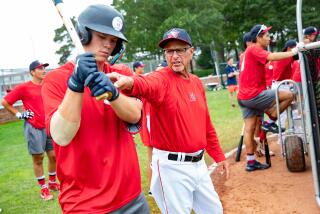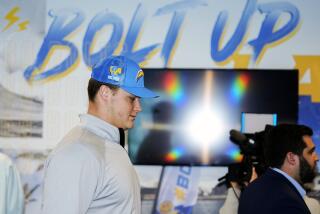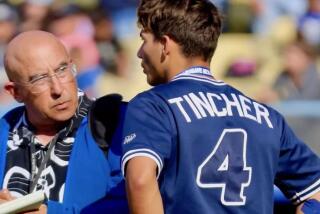In the On-Deck Circle
The boys of spring are sprawled on emerald carpets of grass in Arizona and Florida, stretching under the glare of morning sun. He catches a glimpse of them on TV, then tries to concentrate on a political science text or get back to writing that paper for English class.
Gerald Laird could have been one of them. All he had to do was sign on the dotted line. He could have been the only thing he has ever wanted to be: a professional baseball player. And he would have been a pro ballplayer with nearly a half million in the bank.
After hitting .620--yep, .620--as a senior at La Quinta High, the Oakland A’s selected Laird in the second round of last summer’s draft. On that day, he was sure he’d be in spring training right now, not doing homework.
The A’s offered a reported $420,000 signing bonus--a figure Laird says is actually short of Oakland’s final offer--but it wasn’t enough. During the negotiations, Laird fired his first agent, Alan Meersand, and signed with Scott Boras.
Still, the parties never reached an agreement.
But then things don’t always work out the way you expect, which is another thing Laird is learning at Cypress College these days.
“Second pick in the second round, man, I was so stoked to go start playing and show what I could do,” Laird said, lounging by a pond on the Cypress campus. “I didn’t expect to be here and I didn’t want to be here. I had a hard time for the first month or so. I sort of just went to class and half-way listened.
“But I got over it and I’ve found out I’m not scared to go to college. I completed 16 units last semester and I’m carrying 18 now. And I’m really having a lot of fun with this team. The guys are great. So I wouldn’t be afraid to come back.”
Hold the cheers, Cypress College baseball fans. Don’t expect to see Laird on your favorite team’s roster again next year. Remember, he also had a full scholarship offer to attend Arizona State, but once the A’s drafted him, it was actually little more than a bargaining tool.
“Arizona State, that has always been my dream school since I was a little kid,” he said. “It was a good option . . . but I always figured I was going to sign [to play professionally].”
Even after negotiations with the A’s ended, the Arizona State scholarship was not a viable option. Had he accepted it, he wouldn’t have been eligible to be drafted again for three years, until after his junior year. And the dream job always took precedence over the dream school.
The A’s and Boras will have about a week after the community college season ends and before the draft in June to see if they can work out a deal. If not, Laird will be eligible for the draft again.
“He always had the idea he would sign right out of high school,” Cypress Coach Scott Pickler said, “so he was pretty down when he first got here. It’s what you’d expect from a kid who figured he’d be out showing the pros what he could do and then ends up at Cypress College. But once it was time to play baseball, the gamer in the boy came out.
“And this kid is an incredible athlete with exceptional tools. He’s a lot of fun to watch.”
The politically incorrect question in the mind of most every scout who has ever seen Laird play is: Why would this kid be wasting his time in college?
Laird is the attractively unusual mix of a catcher with blazing speed--he tied for the Orange County lead with 42 stolen bases last year at La Quinta--and a cannon for an arm.
“He’s a very special talent,” said Bill Pinkham, an assistant at Cypress who was the 31st pick in the 1981 draft and a catcher in the Blue Jays’ minor league organization for years. “He’s the fastest player we’ve had here in my 14 years. He also has great arm strength and great bat speed, all the things you can’t teach.”
But there is still much to refine, and Pinkham is doing his best to polish Laird’s receiving skills and give Boras even more than raw athleticism and potential to work with during this summer’s negotiations.
“We’re working on the finer points of blocking the plate and learning to be the field general a catcher has to be out there,” Pinkham said. “I mean, this is an 18-year-old kid and there’s a lot to learn. But his eyes are wide open. He’s a really good kid, a good person, and he wants to learn everything he can about this game.”
Community college baseball diamonds may not be the proving ground on which Laird planned to wage his baseball battles this spring, but it’s where he’s at and he’s making the most of it. He’s one of the 13-3-1 Chargers’ leading hitters with a .432 batting average. He leads the team with 27 runs in 17 games and has eight stolen bases in eight attempts.
“The game’s a little faster [than high school] and the pitching is a little better too,” Laird said. “It’s a chance to get better and it has been awesome playing with this bunch of players. They all play really hard.
“It’s not like I feel any pressure. I don’t have to carry this team. There are a lot of really good players here, and I don’t think I have to prove to the scouts I can play. I’m just going out trying to win and trying to have fun.”
Maybe because he’s a catcher and knows exactly how frustrating and disruptive an accomplished base stealer can be for his opponents, Laird says stealing a base is the best way to have fun. But you don’t see many major league catchers among the league leaders in stolen bases. And you’ll notice that Astros’ All-Star Craig Biggio, a former catcher, is now a second baseman.
Laird is convinced he can squat and run in the majors one day, as long as he works to keep his legs stretched out between innings. But Pinkham, who admits he was never too speedy to begin with, isn’t as sure.
“In the low minors, you play like 144 games in 147 days and that can really take a toll on your legs if you’re catching most of those games,” he said. “To tell you the truth, I think about 25 of the 30 teams would start him in the minors as a catcher but the other five would probably move him to center field right now.
“I just don’t see how, over time, catching wouldn’t affect his speed. But who knows, maybe he’ll be the exception.”
In any case, whether he’s behind the plate or staring into a catcher’s glove from center field, Laird figures to be an official boy of summer by June.
“One way or the other,” Pickler said, “I’m sure he’ll sign after this year.”
More to Read
Get our high school sports newsletter
Prep Rally is devoted to the SoCal high school sports experience, bringing you scores, stories and a behind-the-scenes look at what makes prep sports so popular.
You may occasionally receive promotional content from the Los Angeles Times.






